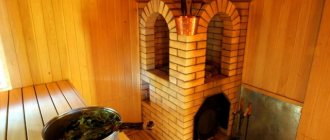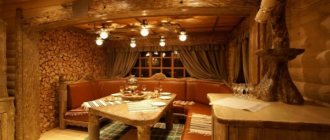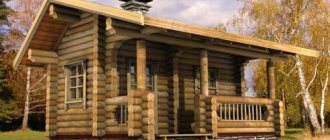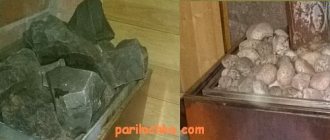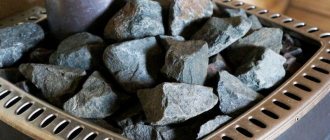- Options for lining for a steam room
- Choosing a lining for a waiting room
- Lining for walls outside the bathhouse
- Criteria for choosing lining
- How to process lining
- Types of lining for a bath
- Calculate the area of the internal lining
- Panel selection table
Wooden lining is considered the best finish for a bathhouse.
This is an environmentally friendly material that creates a favorable microclimate in the room. Wooden paneling for sauna
Choosing a lining for a waiting room
In this room the temperature and humidity are lower than in the steam room. Therefore, for finishing you can use wood of any species, incl. and conifers. They will give off a pleasant aroma. The lining made from pine is cheaper, the more expensive is the one made from birch, aspen or linden.
If you plan to cover not only the walls of the dressing room, but also the ceiling, it is recommended to take material from wood of the same species. There is no need to coat the surface with varnish or paint. But in order to protect it from moisture and pests, an antiseptic is used. It is also used for wood that will be used to sheathe the steam room. In addition, the material is impregnated with fire retardants to increase the level of fire safety and extend the service life of the products.
Classification by variety
In addition to the division by profile, specific processing, tongue-and-groove lock design, lining differs by grade. The designation used is the Latin letters A, B, C and two additional, elite types - “Premium” and “Extra”. All of them mean the quality of the wood and standardize the presence of minimal defects (wood defects) strictly in accordance with the class requirements.
For example, if “A” may have dry (unfallen) knots, then “premium” should not have them at all. Technically, varieties differ only in these indicators, and not in production or processing technology. The cheapest is “C”, you shouldn’t expect anything special from it, this is the lowest quality lining. There is some connection between the grade and the recommendations for use: it is believed that “B” category is optimal for walls, and “A” for ceilings.
Generally speaking, regarding the quality characteristics, the humidity requirement for the carriage board is no more than 12%. It is clear that the average consumer will not be able to verify or refute this indicator; this requires special equipment and laboratory tests. The humidity parameter must be indicated in the documents for the lumber; if it is not there, you should separately request the technical specifications (certificate) from the seller.
To figure out which type of lining to choose from those offered on the market, what type of wood it is made from, you need to first determine the technical conditions for the operation of the purchased board. They are completely different on the lining of the balcony, the dressing room, the bathhouse itself (even within the walls and ceiling). In proportion to these requirements, as well as the cost estimate, the required type of lumber is selected.
It is not at all necessary to save unnecessarily, leaning towards cheap pine or spruce, low-quality lining profiles, and, at the same time, buy super expensive varieties of oak and ash. It is always possible to find a reasonable compromise. The main condition is to purchase a high-quality profile with consistent parameters and normalized humidity. It is then that the decoration of the home steam room will delight the owners for a long time, bringing them benefit and pleasure.
Lining for walls outside the bathhouse
It is customary to clad the premises in the bathhouse with wood. But this material can also be used for external cladding. However, higher demands are placed on it, since the aggressive influence of the external environment is great.
According to the profile shape, “American” or “block house” is more often used, i.e. imitation timber. As for the type of wood, coniferous or aspen are suitable.
Wooden lining for a bath
Briefly about the main thing
A modern finishing material is lining for steam rooms and other bathhouses. Pine, aspen, oak, linden, cedar slats and alder panels are produced with Shtil, Euro, Standard, Soft-line profiles. They differ in the presence or absence of rounded corners and the length of the spike. At the same time, manufacturers produce regular and eurolining. It is European standard lumber that is used for interior decoration of bathhouses. Its installation on the walls and ceiling is carried out after installing the sheathing, laying insulation and vapor barrier, and securing the counter-batten.
Ratings 0
Types of lining
There are different types of lining. The choice depends on several factors: where it is installed indoors, whether it is used for outdoor work, what the climatic conditions are in the region, etc.
Eurolining
Types of eurolining have a common feature - the presence of ventilation gutters, which are located on the back side of the panel, in the longitudinal direction. They provide an outlet for moisture that collects on the walls of the bathhouse. If you do not provide a ventilation system, the material will “lead.” And here the ventilation is already there, no additional work will be required.
Eurolining
Lining - "quarter"
The lining is also made of wood, but a quarter is used on the back and front sides. This design feature is considered the main advantage, since it facilitates installation - it will not be possible to connect such boards incorrectly. However, the material is not suitable for exterior finishing of a bathhouse, since there is no tongue-and-groove connection.
The lining can only be installed horizontally: when laying vertically, it is impossible to connect the lamellas with a sufficient degree of strength.
Quarter paneling is not as popular as it used to be. It does not provide a tongue-and-groove connection. Under the influence of temperature and high humidity, the coating can diverge greatly.
Quarter paneling
American lining
This is a universal variety. It is used mainly for the outer cladding of the bathhouse. The difference between the lining is the shape of the lamellas - an irregular triangle.
The end of the panel, which is larger, is equipped with a groove designed for mounting a narrower end. “American” can be laid with an overlap. This helps protect the joints from environmental influences.
At the same time, the flat front side of the “American” looks like a beam, which makes it attractive.
The difference between this lining is its massiveness. The width is at least 14 cm and the thickness is at least 2 cm.
American lining
Block house lining
The difference is the rounded front side, which allows you to imitate a rounded log. There is a tenon at the top of the lamellas and a groove at the bottom. “Block house” is made not only from natural wood, but also from metal or polymers. Any of the materials is suitable for the exterior decoration of bathhouse walls.
The advantage is the accuracy of the geometry, which simplifies and facilitates installation work.
Block house lining
"Peasant" paneling
This is how standard lining is called for its simplicity of design, since it is characterized by smooth and flat panels.
This is a practical and convenient finishing material. Thanks to a shorter tongue (compared to other types), the “peasant” lamellas are connected tightly, thanks to which you can get a solid wall with virtually no gaps.
"Peasant" is suitable for exterior decoration in regions with high wind loads. It provides the building with protection from cold air flows.
Peasant paneling
Imitation timber block house
This lining is a block house. Some manufacturers just call it imitation timber.
Lining imitation timber block house
Installation
The casing of a sauna or bathhouse involves installing the lining using two fastening methods: vertically or horizontally. Horizontal fastening is carried out by laying lamellas, which are located parallel to the floor, and vertically - perpendicular. The horizontal method is more often used in practice, when installation is carried out with a tenon located at the top, and the groove of the next rail is put on the tenon of the previous one. This method is advantageous in that in case of persistent contamination, replacing panels is much easier than with vertical installation. As a rule, the horizontal method is used in Russian baths, where the steam is wet. The vertical method is suitable for Finnish saunas with dry steam.
Fastening is carried out:
- through connection with self-tapping screws or nails;
- hidden on screws or nails;
- on clamps (hidden).
The hidden fastening option is preferable, as it eliminates burns when touched during the steam room.
Calculate the area of the internal lining
It is necessary not only to choose the type of lining, but also to make the necessary calculations in order to buy the required amount of material (with some margin).
The area taken into account is not the area of the room, but its walls, and sometimes the ceiling, since lining is not used for the floor.
For example, a bathhouse consists of 2 rooms. The area of the steam room is 3x2 (m), and the area of the dressing room is 3x1 (m). At the same time, the ceiling height is standard - 2.5 m.
Then the following algorithm is used:
- The area of 2 walls of a steam room 3 m long is 3 x 2.5 = 7.5 m (the total figure will be 15 m).
- The area of the short walls is 5 sq.m., and the total area is 10 sq.m.
- The area of the ceiling covering is calculated as 2x3=6 m.
- To finish the steam room, the lining should be 15+10+6=31 sq.m.
A similar algorithm is used for the waiting room. With the given values of material, you need to buy enough to be enough for another 23 sq.m.
Wooden lining for a bath
How to take measurements correctly
To buy the required amount of lining, you will first have to make accurate measurements - this is the only way to make calculations.
To do this you need:
- Measure the length, width and height of the walls in the steam room and dressing room.
- Mark the location of the oven. For fire safety reasons, the walls near it are finished not with clapboard, but with tiles or natural stone (the width of such a zone should be at least 40 cm).
- Calculate the planned insulation thickness.
After taking measurements, you need to decide what type of installation to implement - vertical or horizontal.
For example, the ceiling height is 2.5 m, and the vertical method is chosen for finishing. Then you need to look for lining 2.5 m long. The walls will be finished with such panels. When covering the ceiling, their length depends on the width of the room. With the horizontal cladding method, they look for material whose length is equal to the width of the wall: in the example above it is 3 m.
A bathhouse almost always needs insulation. Therefore, measurements are taken taking into account the installation of the frame and the thickness of the insulation.
Lining area (square meters)
When purchasing material, it is better to enlist the help of a specialist who can help you calculate the required amount of material. Or you will have to do additional calculations yourself, since products are sold by cubic meters, and the required area for covering is calculated.
There are special tables that indicate how many square meters of lining are contained in 1 cubic meter of material. Moreover, the length of the products is taken into account. For example, with an indicator of 3 m in 1 cubic meter - 278 boards of size 96x12.5 mm. A specialist will help you perform more accurate calculations.
Wood species
Below you will find a list of wood species that you can buy at a lumberyard: their features, qualities, pros and cons.
Linden
After conifers, linden is preferred - the cheapest species.
It makes a good lining for a steam room because:
- Linden “seals” the room, preventing heat from escaping;
- Distributes temperature evenly;
- Does not crack from excessive changes.
Low thermal conductivity solves the problem of burns, even if you lean your whole body against the wall. Linden is not afraid to come into contact with water, so you don’t have to worry about cracks.
Aspen
Aspen and linden have approximately the same qualities, but the former is a little more expensive.
Aspen lining for a bathhouse has poor thermal conductivity and is also not afraid of water.
You can safely steam at least every day - the lining will live for at least 10 years.
Aspen for a bathhouse is inferior in that it is very difficult to find good boards. At lumber yards it is presented in a smaller selection and often has class “B” and lower (there are knots and small defects).
Aspen has an amazing effect - gradual hardening.
The rock itself is soft, but over time it acquires enormous strength. Even a nail goes into wood with difficulty.
If the aspen has darkened over time, light sanding with sandpaper is sufficient. Only the top layer (about 1 millimeter) is oxidized.
Alder
Alder for baths is a traditional material used for several hundred years.
Has exceptional qualities:
- Thermal conductivity is minimal. The panels remain barely warm, even if the steam room is over 80 degrees.
- Smooth surface. Even unplaned ones require almost no processing.
- Water resistance. Can last more than 20 years without cracking.
Due to its natural qualities, humidity almost does not deform alder.
After drying, it returns to its original state.
Siberian or Canadian cedar
You can use cedar for a bathhouse if you are going to make it for centuries. Wood is very expensive and is not sold everywhere.
It has a characteristic brown color with a pink tint. It is not inferior in strength to oak, so processing is very difficult. It does not release resin, but when heated, essential oils begin to evaporate, filling the steam room with a pleasant aroma.
Over time, cracks and rotting do not form, even if you do not cover them with varnish or oil.
As a rule, cedar lining for a bath is used in a specific room - a steam room.
It makes no sense to decorate other rooms.
Larch
To the question: “Which clapboard is better to cover a bathhouse?” - many answer - larch.
This is a coniferous species, but its qualities differ from pine:
- Moisture resistant. Comparable to cedar, since the tree grows in conditions of high humidity. Not subject to cracks and rotting, even with daily use of the bath.
- Strength. It is almost impossible to break it, and there are no traces of impact, like on pine.
These qualities come at the price of thermal conductivity. The density of wood causes it to heat up due to temperature.
In addition, larch is very capricious in processing. It may crack during sawing or planing.
Oak
Oak lining for a steam room is now considered the standard. It has excellent resistance to moisture and temperature. If the oak is initially well dried, moisture does not accumulate in it.
The thickness of the sauna lining is usually more than a centimeter. The slats are heavy and massive, which complicates their installation. In addition, oak is very difficult to work with. Cutting it with a hand saw is not an easy task, so you need a power tool.
The price of oak is high.
Significantly higher than pine, larch, alder and linden. However, all the shortcomings are covered by 25 years of operation without visible damage.
Pine
Pine lining for saunas and baths is rare. It can be used for lining the entrance or dressing room, but not for a steam room with a steam room.
When heated, pine releases resin, which heats up to the temperature of steam - this is a 100% burn. In addition, it can stain towels or skin. Resin will be released with each kindling, so it will not be possible to etch it away.
Pine is ideal for dressing rooms and washrooms.
This is one of the cheapest breeds and is not susceptible to rotting or cracking. It is easy to work with, although due to its high viscosity it is difficult to grind and polish.
Rare breeds
Exotic breeds for baths are rarely used, only if luxury class is intended.
Among them the most common:
- Abash. African rock, which is characterized by high porosity. For this reason, it does not heat up at all even if the temperature approaches 100 degrees.
- Hemlock. An exotic pine species native to North America. It has extreme porosity and durability. Quite fragile, but does not have resinous secretions. It is ideal for the steam room, as it is impossible to get burned.
Conclusion
How many people - so many options for finishing a bathhouse with clapboard, one thing remains unchanged - the naturalness and naturalness of this product
It is the lining for a bath that is a material that can give it a look that promotes good rest and has a beneficial effect on the body. Our portal is ready to provide you with methods for finishing interior bath rooms, as well as much other information, and, of course, you should watch the video in this article.
Did you like the article? Subscribe to our Yandex.Zen channel
Other ways to properly finish a steam room: impregnation
Siberia is not everywhere in Russia




